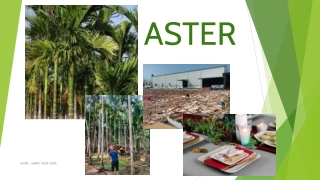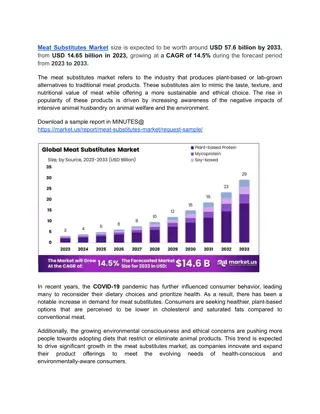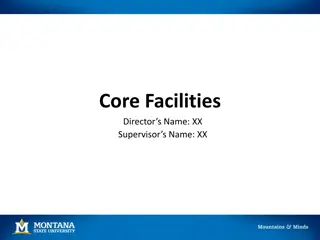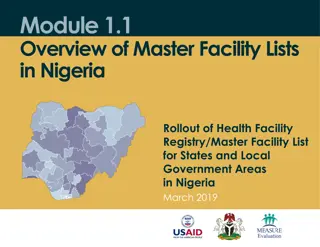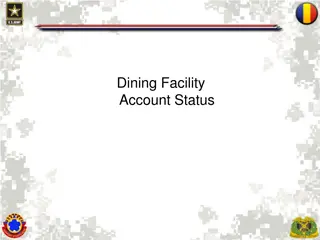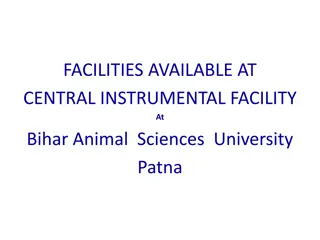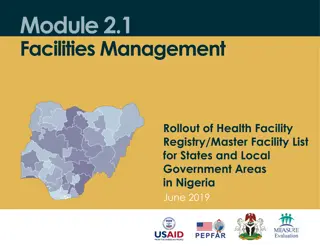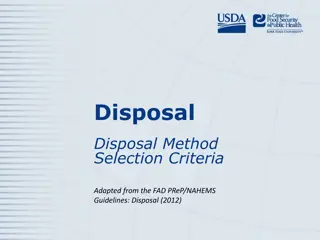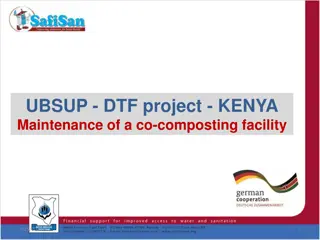Foodservice Facility Management Guidelines
Ensure proper hygiene and organization in foodservice facilities to uphold safety standards. Guidelines include procedures for boiling water, setting up hand wash stations, utilizing dressing rooms, maintaining janitorial facilities, managing storage areas effectively for food and non-food items, and implementing storage guidelines. Prioritize cleanliness, separation of food and non-food items, and proper storage practices for a well-run foodservice operation.
Download Presentation

Please find below an Image/Link to download the presentation.
The content on the website is provided AS IS for your information and personal use only. It may not be sold, licensed, or shared on other websites without obtaining consent from the author.If you encounter any issues during the download, it is possible that the publisher has removed the file from their server.
You are allowed to download the files provided on this website for personal or commercial use, subject to the condition that they are used lawfully. All files are the property of their respective owners.
The content on the website is provided AS IS for your information and personal use only. It may not be sold, licensed, or shared on other websites without obtaining consent from the author.
E N D
Presentation Transcript
Procedure for boiling water 1. Put water in a clean and sanitized pot; 2. heat water until it is brought to a rapid rolling boil; 3. continue rolling boil for at least five minutes; and 4. after five minutes, if necessary, cool water by placing it in another sanitized container and storing it in the refrigerator.
Hand Wash Station All hand wash stations must be equipped with liquid soap dispensers. A hand washing sign with proper hand washing procedures. Single-use hand drying devices such as paper towel dispensers. Hand wash stations must have adequate hot and cold, (warm) running water. Self-closing faucets should flow for at least 20 seconds, without the need to reactivate the faucet. A waste receptacle for used paper towels and gloves (if used).
Dressing Rooms Putting uniforms on at home can result in contamination of these clothes at home, during transit to work, and during other non-work related occasions. Dressing rooms can promote the practice of having dedicated clean and sanitary work uniforms. Separate dressing rooms can minimize potential contamination and the wearing of street clothes in food preparation areas.
Janitorial Facilities In a foodservice operation, a janitorial facility should: Be located away from food handling areas; Be equipped with a service sink or curbed cleaning facility to dispose of waste water; Be equipped with a floor drain, for the cleaning of mops and for the disposal of mop water and similar liquid waste; Have a place to store brooms, mops, pails and cleaning equipment.
Storage Areas Food, food ingredients, equipment, non-food materials (i.e.utensils, linens, packaging) and chemical agents. All food items must be stored in a separate location away from non-food items including packaging materials.
Storage Guidelines Keep food 5cm (2 inches) away from the wall. Keep food 15cm (6 inches) off the floor.
Non-food Storage Keep linens, packaging, and single service utensils/containers away from contamination from food, equipment and non-food materials such as chemicals. Landscaping tools, marketing materials and posters must also be stored to minimize contamination of food. Store personal belongings of employees separately from food storage and food preparation areas.
Recyclables Recyclables need to be stored in a sanitary manner and removed regularly to prevent pest infestations. Un-rinsed, improperly stored food containers can attract insects.
Summary Locate buildings away from potential sources of contamination and design with a forward flow to reduce cross contamination; Floors walls and ceilings must be easy to clean and maintain; Utilities such as lighting, ventilation, plumbing, water supply and sewage must be safe and sufficient; Garbage must be properly stored and frequently removed to prevent contamination of food and infestation of pests; Personal hygiene must be supported with facilities such as hand wash stations, restrooms and dressing rooms; and Food and non-food storage areas must be properly designed to prevent contamination of food.
Equipment Installation If you can t clean equipment properly it can contaminate the food you are preparing. Attach fixed equipment to surrounding walls, floors, or other equipment; or Space it in a manner to allow for cleaning under and around equipment and prevent the accumulation of dirt. Equipment should be installed by licensed professionals and must meet all local, provincial and national regulatory requirements.
Food Contact Surfaces Ensure that the food contact surfaces: Are corrosion resistant, smooth, non-absorbent and easy to clean to eliminate contaminants; Non-toxic, free from pitting, cracks and crevices; Do not introduce substances into food, such as colour, odours and tastes or substances (metals) which are harmful; and Are durable for the safe preparation and cooking of food.
Wooden Food Contact Surfaces Can deteriorate becoming difficult to clean and prone to food contamination; Must be re-surfaced (or discarded) if they are too worn to clean and sanitize; Can be used for cutting boards; cutting blocks; baker's tables; and utensils such as rolling pins, doughnut dowels, salad bowls, chopsticks, and wooden paddles.
Clean in Place Equipment Cleaning and sanitizing solutions must contact all interior food contact surfaces. Must be capable of being completely drained of cleaning and sanitizing solutions. Should be inspection access points to ensure equipment is effectively cleaned.
Heating & Cooling Equipment Must achieve and maintain temperatures to prevent, eliminate or reduce growth of harmful micro-organisms. Must be equipped with devices to monitor and control temperatures. Temperature measuring devices on the equipment must be easily readable and accurate to 1.0 C (2.0 F).
Calibration Submerge the probe Calibrate Make an Ice Water Solution Check the Temperature
Summary Equipment should be located where it is easy to properly maintain Equipment must be safe for use with food and be designed to prevent, eliminate or reduce potential hazards Food contact surfaces should be smooth making them easy to clean and sanitize Equipment should be regularly maintained according to manufacturer s recommendations Frequent calibration ensures the equipment is working properly to keep food safe
Choosing a supplier The company should: Be reliable; Use refrigerated delivery trucks; Train their employees in food safety; Use clean, protective, leak-proof packaging; Ensure deliveries arrive during off-peak hours; Cooperate with employees inspecting the food; Allow you to inspect their delivery trucks and production facilities.
Approved Suppliers The following must be purchased from approved suppliers: Potentially hazardous food such as meat, poultry, fish, eggs and milk; Foods in sealed containers and/or products packaged under modified atmosphere packaging; Meat from commercial game farms that raise, slaughter and process the animals. Note: Government-inspected and graded foods should have an inspection stamp like the ones below.
Unapproved Sources Do not buy: Food that has not been prepared in a place approved by the health authorities; Wild game that has not been inspected and approved by the health authorities. In some jurisdictions, regulatory authorities may allow some exemptions to this requirement. Check with your local regulatory authority.
Steps to Receiving 1. Check the truck. 2. Check for temperature abuse. 3. Avoid cross contamination. 4. Properly labelled supplies. 5. Packaging intact. 6. No pests.
Shipment Rejection If any food is unacceptable then it must be rejected. Get a credit note and return the food. Keep records of suppliers that delivered food that was rejected. If the problem is repeated too often you will need to find a different supplier.
Disposal of Rejected Food If food is rejected you must keep it away from safe food to prevent cross contamination. Follow these steps: 1. Mark the food with a label or mark on the package Rejected do not use ; 2. Put all rejected food in a place separate from your safe food to prevent contamination; 3. Have the supplier pick up the rejected food or put it in the garbage.
Storage Proper storage and rotation of food reduces spoilage and potential contamination. Quality and freshness help ensure happy customers.
FIFO To maintain a First In First Out storage system: 1. Write on each food package/box/container: a. the expiration date, or; b. the date the item was received, or; c. the date the item was put into storage. 2. Shelve new products behind old products; 3. Regularly check expiration dates to ensure older product is used first; 4. Never use products past their expiration date.
Refrigerated Storage Keeping products at refrigerated temperatures helps to decrease the growth of microorganisms in food. Food must be maintained at 4 C / 40 F or lower.
Refrigerated Storage Guidelines Check food temperatures regularly with a sanitized and calibrated thermometer. Place hanging thermometers in the front and back of refrigerators. Do not overload refrigerator shelves or line them with foil or paper because this prevents proper airflow. Store raw meat, poultry and fish separately from cooked and ready-to-eat foods to prevent cross- contamination. Wrap, label and date food to prevent cross- contamination and use oldest product first.
Top Down Storage Top Down Storage Fish; Whole cuts beef, pork, ham, sausage, bacon; Ground beef & pork; Poultry.
Frozen Storage Frozen foods must be received and maintained in a solid frozen state at a temperature of -18 C (0 F) or less.
Frozen Storage Guidelines Monitor freezer temperature daily. Rotate food using the FIFO method. Discard food that is damaged from freezing. Defrost the freezers frequently. If possible move frozen food to another freezer during defrost.
Dry Food Storage Foods not requiring refrigeration or frozen storage, must be stored in a clean, well ventilated, well lit, enclosed area, specifically designated for food storage.
Dry Food Storage Guidelines Temperature between 10 C to 21 C (50 F and 70 F). Humidity should be 50 to 55 %. Store dry foods 15 cm (6 inches) off the floor. Away from direct sunlight and heat. Store foods in original packages.
Chemical Storage Guidelines A dry, well lit, monitored area; Separate from food and food contact surfaces; Kept in original packaging with instructions; and Returned to storage after use to prevent cross contamination.
Food Preparation Potentially hazardous foods must not be exposed to temperatures between 4 C and 60 C (40 F and 140 F) for longer than four hours total accumulated time. During preparation, food must not be contaminated by other sources in the foodservice operation.
Preparation Guidelines Wash your hands before preparing food; Prepare quickly, in batches to decrease time in the temperature danger zone; Avoid cross-contamination from foods containing allergens or potentially hazardous raw foods; Minimize advance preparation time ; and Label products to ensure FIFO.
Thawing Potentially hazardous foods must be thawed in a manner that will prevent the rapid growth of harmful bacteria.
Thawing Methods Cold running water Refrigeration thawing Microwave thawing Part of the cooking process
Cooking Meat Raw foods of animal origin, and food mixtures containing raw foods of animal origin, must be cooked to heat all parts of the food to the minimum temperatures and for the minimum times outlined.
Cooking Guidelines To cook to the proper temperature, and kill bacteria: Cook food in small batches; Stir when cooking large quantities of liquids; Cook in one continuous process (i.e. whole turkeys and large cuts of beef); Cook dressings/stuffing separately because they act as an insulator keeping part of the food in the temperature danger zone.
Cooking Guidelines for Different Foods 70 C (158 F) 74 C (165 F) 85 C (185 F) 70 C (158 F) 70 C (158 F) 63 C (145 F)
Microwave Cooking & Reheating Microwaves can be used for cooking and reheating. Special guidelines must be followed to ensure the food reaches the recommended time and temperature relationship when microwave cooking. Note that microwave ovens lose their power over time, and therefore temperature levels and even cooking should be checked periodically.
Microwave Guidelines Food heated in a microwave must be: Rotated or stirred during the cooking process; Allowed to stand covered for at least 2 minutes after cooking; Heated to higher temperatures (as per manufacturers instructions) to compensate for shorter cooking times; Checked in several places with a probe thermometer when the food is removed from the oven to ensure there are no cold spots.
Holding We will review 3 types of holding: 1.Hot Holding; 2.Cold Holding; and 3.Room Temperature Holding.
Hot Holding Potentially hazardous foods that have been prepared, cooked, and are to be served hot, must be held at a temperature of at least 60 C (140 F) until served. To maintain hot holding temperatures the equipment needs to be higher than 60 C (140 F).Measure the food temperature with a calibrated thermometer every two hours. Hot holding equipment includes: steam tables, double boilers, bain-maries, heated cabinets and chafing dishes.
Hot Holding Guidelines Good practices for hot-holding include: Using hot-holding equipment to keep food hot, not for cooking; Nevermix new food with old food when restocking; Never mix raw food with cooked food; Using sneeze guards for food on display (i.e. buffet service);and Checking food temperatures every two hours.
Cold-Holding All potentially hazardous foods must be stored at a temperature of 4 C (40 F) or less.
Cold-Holding Guidelines Good practices for cold-holding include: Checking the temperature of foods being kept cold (i.e. salad bar) every two hours; If using ice to keep "ready-to-eat" food cold, never put the food directly on the ice. Put the food in pans or on plates; Sneeze guards are required on buffets.
Room Temperature Holding Potentially hazardous foods intended for immediate consumption, may be held for service (not kept on ice or other equivalent methods). This is a risky practice which should be kept to a minimum.
Room Temperature Holding Foods must be marked with the time at which they were removed from temperature control. After no more than 4 hours food must be discarded. Cover foods to prevent them from being contaminated.
Cooling Cooked potentially hazardous foods, intended for refrigerated storage prior to serving, must be: 1.Cooled from 60 C (140 F) to 20 C (68 F)or less within two hours; 2.And then from 20 C (68 F)to 4 C (40 F) or less within four hours.
Cooling from Room Temperature Potentially hazardous foods prepared at room temperature, intended for refrigerated storage prior to serving, must be cooled from room temperature 20 C (68 F) to 4 C (40 F) or less within four hours.




